Leadership and Management: A Report on Trait Leadership Theory
VerifiedAdded on 2021/01/01
|19
|5354
|221
Report
AI Summary
This report provides a comprehensive overview of trait leadership theory, delving into its definition, evolution, and key constituents. It contrasts leadership and management, exploring the 'Great Man' theory and the 'Big Five' personality factors. The report examines the major traits of effective leaders, including intelligence, determination, self-confidence, and integrity. It further analyzes the strengths and limitations of the trait leadership style, reflecting on its applicability and impact. The report also includes reflective accounts and examples of transformational leaders like M. K. Gandhi, Abraham Lincoln, and Elon Musk, based on their personality traits. The document concludes with an evaluation of the theory's practical implications and significance in contemporary leadership contexts.

Critical Reflective
Evaluation Report
Evaluation Report
Paraphrase This Document
Need a fresh take? Get an instant paraphrase of this document with our AI Paraphraser
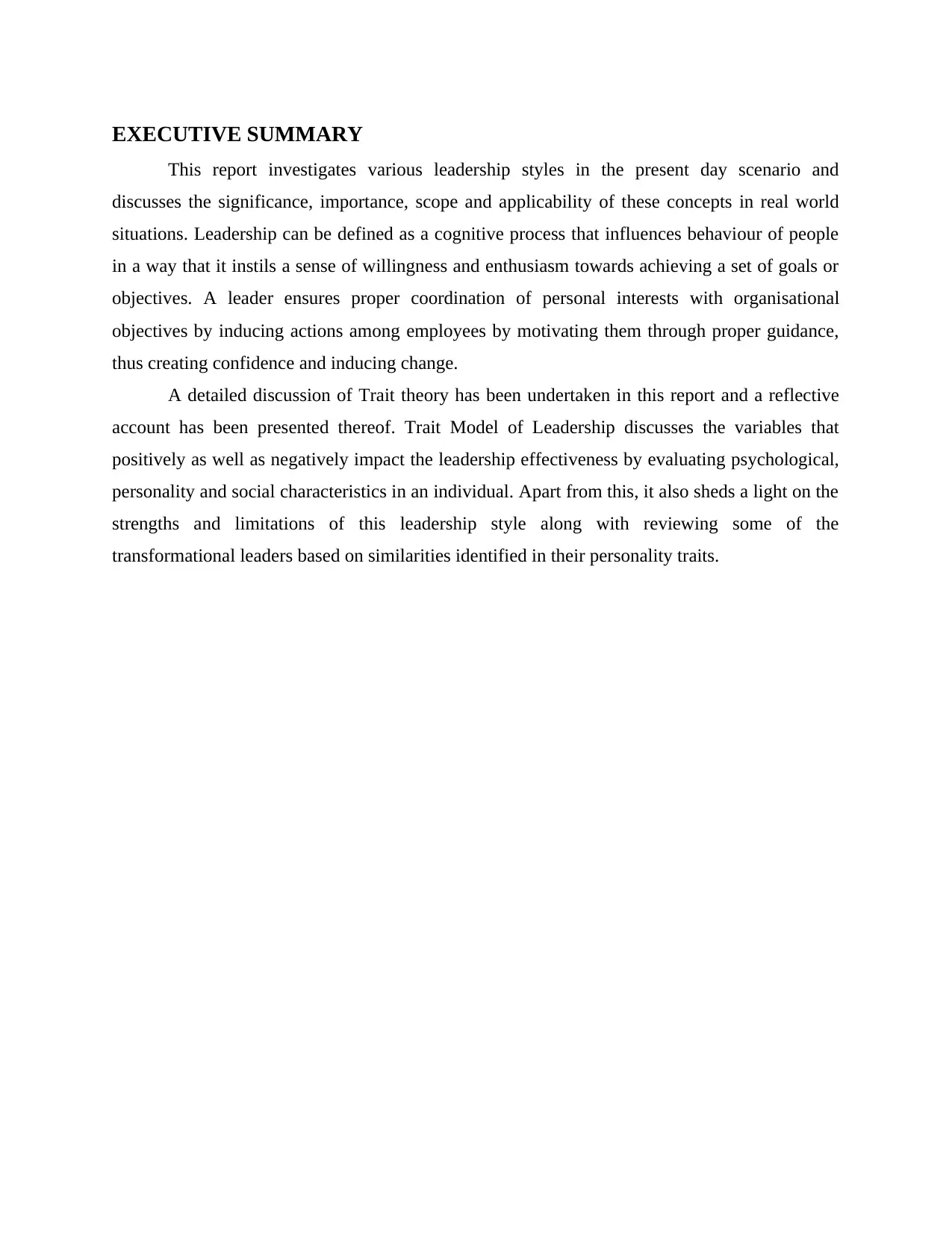
EXECUTIVE SUMMARY
This report investigates various leadership styles in the present day scenario and
discusses the significance, importance, scope and applicability of these concepts in real world
situations. Leadership can be defined as a cognitive process that influences behaviour of people
in a way that it instils a sense of willingness and enthusiasm towards achieving a set of goals or
objectives. A leader ensures proper coordination of personal interests with organisational
objectives by inducing actions among employees by motivating them through proper guidance,
thus creating confidence and inducing change.
A detailed discussion of Trait theory has been undertaken in this report and a reflective
account has been presented thereof. Trait Model of Leadership discusses the variables that
positively as well as negatively impact the leadership effectiveness by evaluating psychological,
personality and social characteristics in an individual. Apart from this, it also sheds a light on the
strengths and limitations of this leadership style along with reviewing some of the
transformational leaders based on similarities identified in their personality traits.
This report investigates various leadership styles in the present day scenario and
discusses the significance, importance, scope and applicability of these concepts in real world
situations. Leadership can be defined as a cognitive process that influences behaviour of people
in a way that it instils a sense of willingness and enthusiasm towards achieving a set of goals or
objectives. A leader ensures proper coordination of personal interests with organisational
objectives by inducing actions among employees by motivating them through proper guidance,
thus creating confidence and inducing change.
A detailed discussion of Trait theory has been undertaken in this report and a reflective
account has been presented thereof. Trait Model of Leadership discusses the variables that
positively as well as negatively impact the leadership effectiveness by evaluating psychological,
personality and social characteristics in an individual. Apart from this, it also sheds a light on the
strengths and limitations of this leadership style along with reviewing some of the
transformational leaders based on similarities identified in their personality traits.
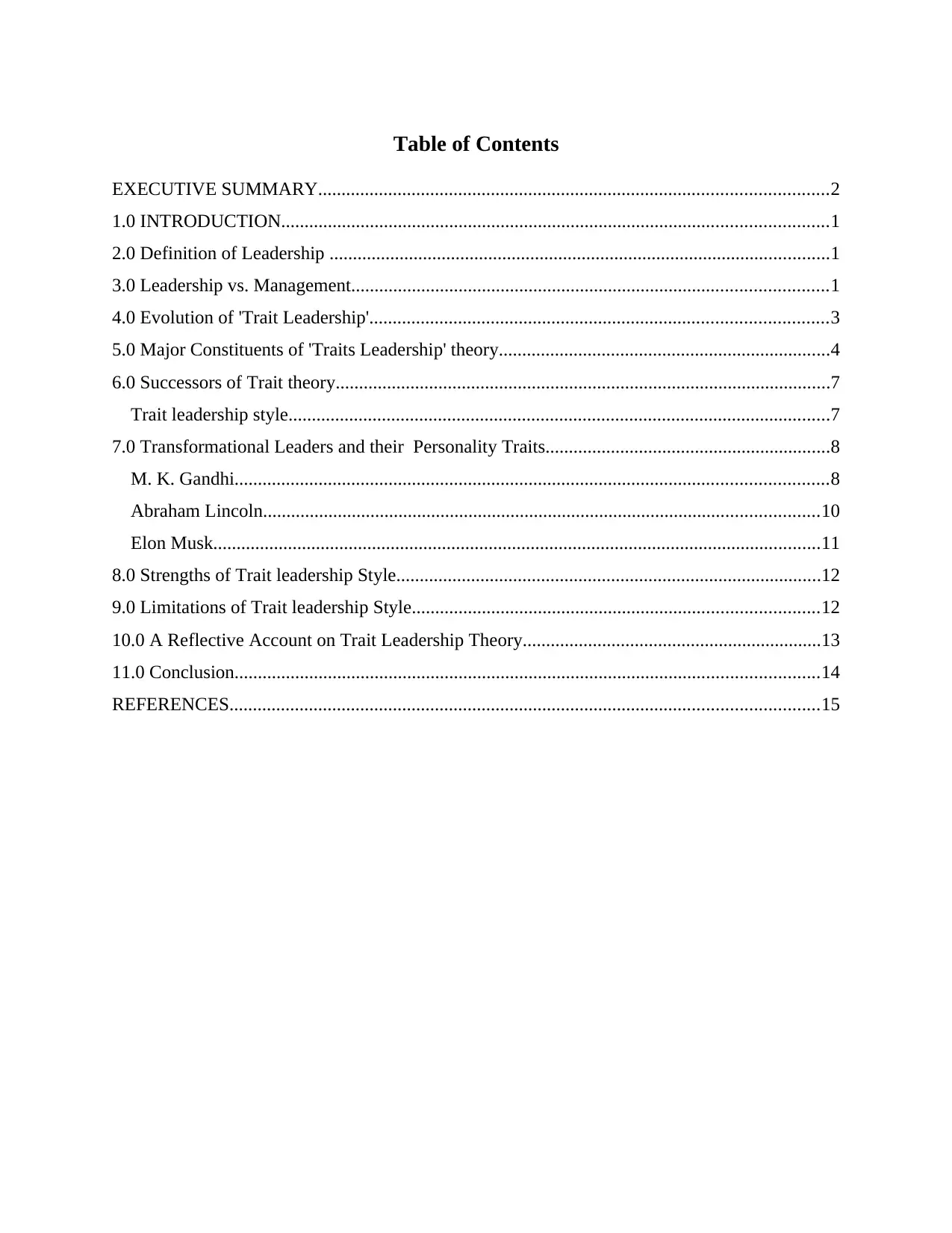
Table of Contents
EXECUTIVE SUMMARY.............................................................................................................2
1.0 INTRODUCTION.....................................................................................................................1
2.0 Definition of Leadership ...........................................................................................................1
3.0 Leadership vs. Management......................................................................................................1
4.0 Evolution of 'Trait Leadership'..................................................................................................3
5.0 Major Constituents of 'Traits Leadership' theory.......................................................................4
6.0 Successors of Trait theory..........................................................................................................7
Trait leadership style....................................................................................................................7
7.0 Transformational Leaders and their Personality Traits.............................................................8
M. K. Gandhi...............................................................................................................................8
Abraham Lincoln.......................................................................................................................10
Elon Musk..................................................................................................................................11
8.0 Strengths of Trait leadership Style...........................................................................................12
9.0 Limitations of Trait leadership Style.......................................................................................12
10.0 A Reflective Account on Trait Leadership Theory................................................................13
11.0 Conclusion.............................................................................................................................14
REFERENCES..............................................................................................................................15
EXECUTIVE SUMMARY.............................................................................................................2
1.0 INTRODUCTION.....................................................................................................................1
2.0 Definition of Leadership ...........................................................................................................1
3.0 Leadership vs. Management......................................................................................................1
4.0 Evolution of 'Trait Leadership'..................................................................................................3
5.0 Major Constituents of 'Traits Leadership' theory.......................................................................4
6.0 Successors of Trait theory..........................................................................................................7
Trait leadership style....................................................................................................................7
7.0 Transformational Leaders and their Personality Traits.............................................................8
M. K. Gandhi...............................................................................................................................8
Abraham Lincoln.......................................................................................................................10
Elon Musk..................................................................................................................................11
8.0 Strengths of Trait leadership Style...........................................................................................12
9.0 Limitations of Trait leadership Style.......................................................................................12
10.0 A Reflective Account on Trait Leadership Theory................................................................13
11.0 Conclusion.............................................................................................................................14
REFERENCES..............................................................................................................................15
⊘ This is a preview!⊘
Do you want full access?
Subscribe today to unlock all pages.

Trusted by 1+ million students worldwide
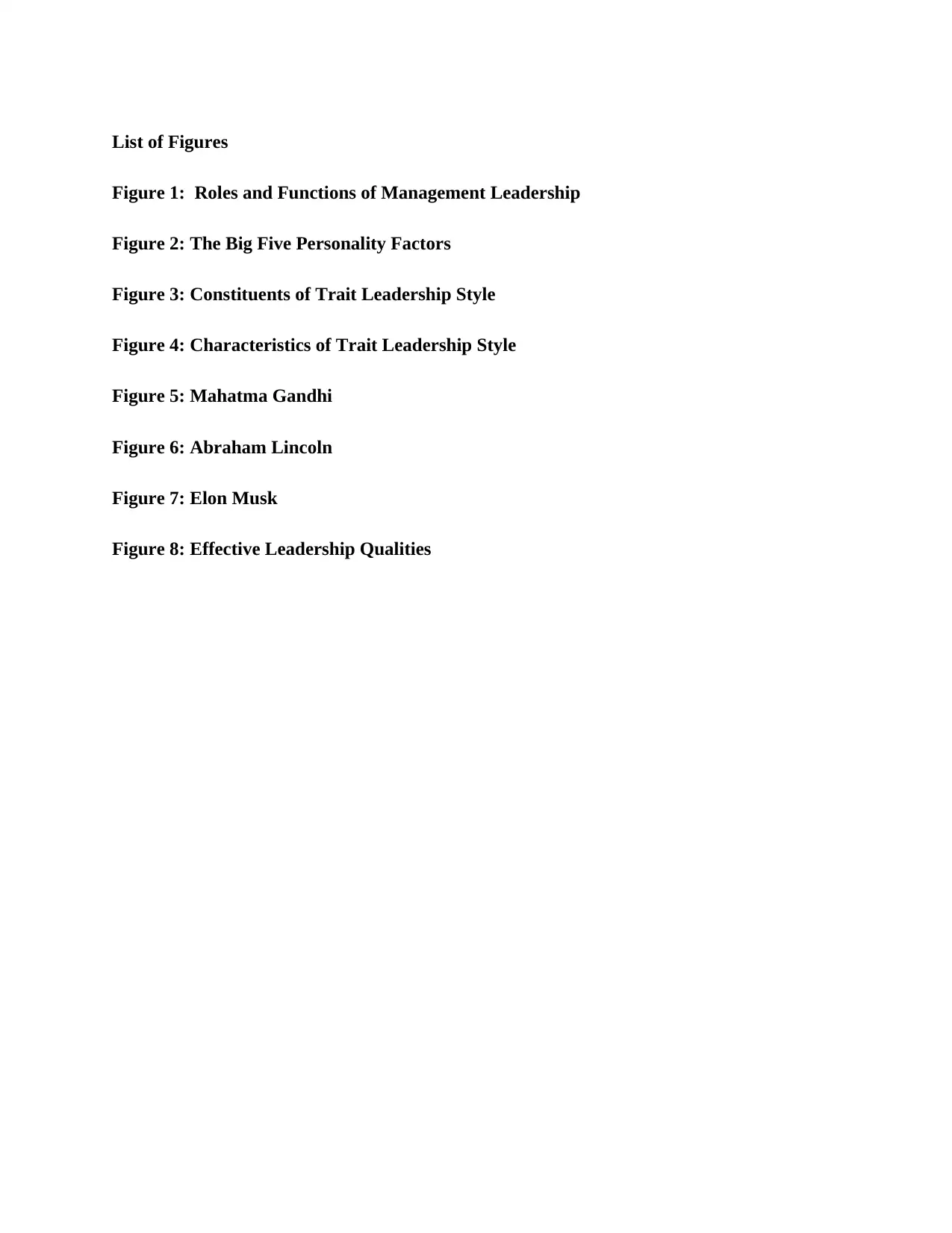
List of Figures
Figure 1: Roles and Functions of Management Leadership
Figure 2: The Big Five Personality Factors
Figure 3: Constituents of Trait Leadership Style
Figure 4: Characteristics of Trait Leadership Style
Figure 5: Mahatma Gandhi
Figure 6: Abraham Lincoln
Figure 7: Elon Musk
Figure 8: Effective Leadership Qualities
Figure 1: Roles and Functions of Management Leadership
Figure 2: The Big Five Personality Factors
Figure 3: Constituents of Trait Leadership Style
Figure 4: Characteristics of Trait Leadership Style
Figure 5: Mahatma Gandhi
Figure 6: Abraham Lincoln
Figure 7: Elon Musk
Figure 8: Effective Leadership Qualities
Paraphrase This Document
Need a fresh take? Get an instant paraphrase of this document with our AI Paraphraser
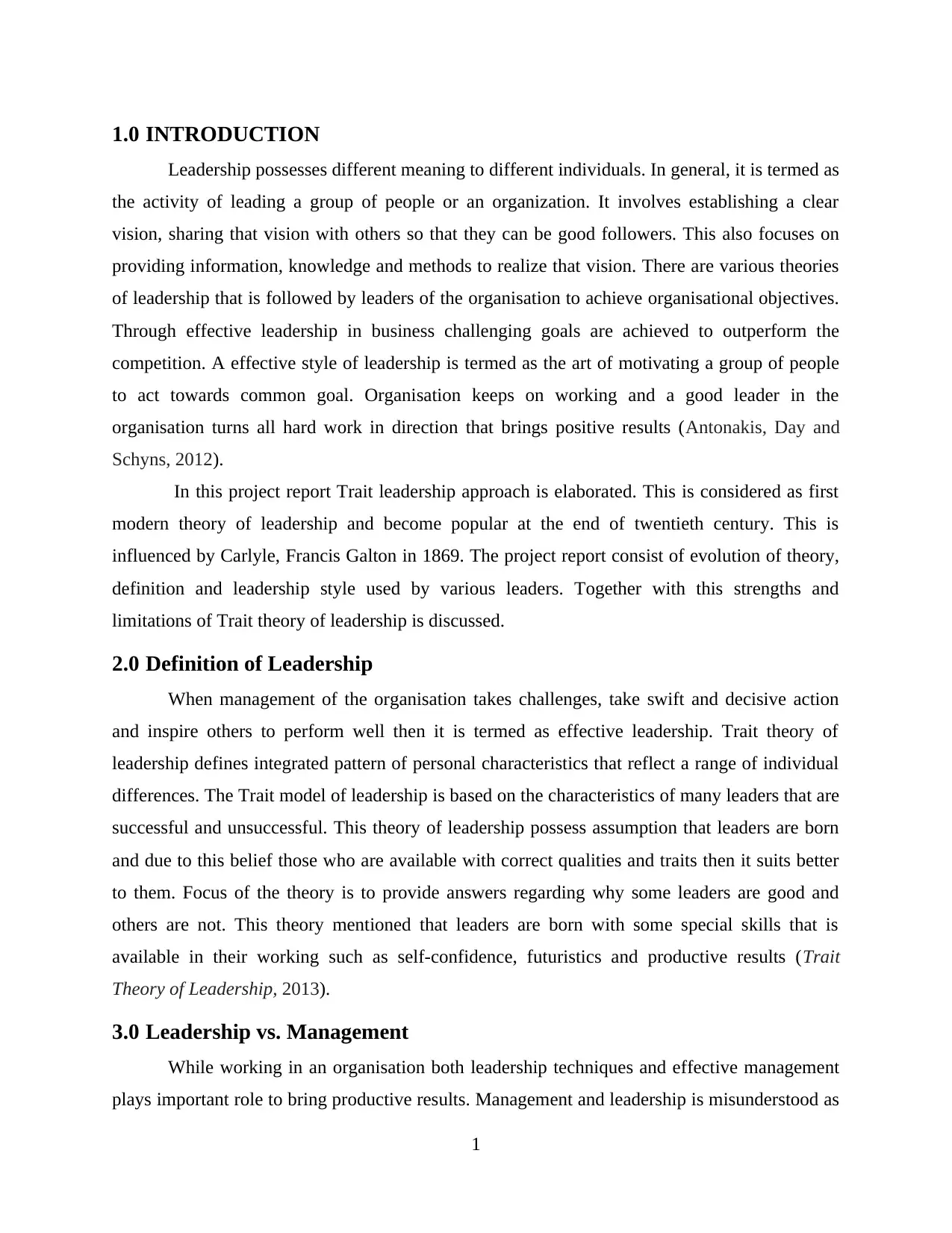
1.0 INTRODUCTION
Leadership possesses different meaning to different individuals. In general, it is termed as
the activity of leading a group of people or an organization. It involves establishing a clear
vision, sharing that vision with others so that they can be good followers. This also focuses on
providing information, knowledge and methods to realize that vision. There are various theories
of leadership that is followed by leaders of the organisation to achieve organisational objectives.
Through effective leadership in business challenging goals are achieved to outperform the
competition. A effective style of leadership is termed as the art of motivating a group of people
to act towards common goal. Organisation keeps on working and a good leader in the
organisation turns all hard work in direction that brings positive results (Antonakis, Day and
Schyns, 2012).
In this project report Trait leadership approach is elaborated. This is considered as first
modern theory of leadership and become popular at the end of twentieth century. This is
influenced by Carlyle, Francis Galton in 1869. The project report consist of evolution of theory,
definition and leadership style used by various leaders. Together with this strengths and
limitations of Trait theory of leadership is discussed.
2.0 Definition of Leadership
When management of the organisation takes challenges, take swift and decisive action
and inspire others to perform well then it is termed as effective leadership. Trait theory of
leadership defines integrated pattern of personal characteristics that reflect a range of individual
differences. The Trait model of leadership is based on the characteristics of many leaders that are
successful and unsuccessful. This theory of leadership possess assumption that leaders are born
and due to this belief those who are available with correct qualities and traits then it suits better
to them. Focus of the theory is to provide answers regarding why some leaders are good and
others are not. This theory mentioned that leaders are born with some special skills that is
available in their working such as self-confidence, futuristics and productive results (Trait
Theory of Leadership, 2013).
3.0 Leadership vs. Management
While working in an organisation both leadership techniques and effective management
plays important role to bring productive results. Management and leadership is misunderstood as
1
Leadership possesses different meaning to different individuals. In general, it is termed as
the activity of leading a group of people or an organization. It involves establishing a clear
vision, sharing that vision with others so that they can be good followers. This also focuses on
providing information, knowledge and methods to realize that vision. There are various theories
of leadership that is followed by leaders of the organisation to achieve organisational objectives.
Through effective leadership in business challenging goals are achieved to outperform the
competition. A effective style of leadership is termed as the art of motivating a group of people
to act towards common goal. Organisation keeps on working and a good leader in the
organisation turns all hard work in direction that brings positive results (Antonakis, Day and
Schyns, 2012).
In this project report Trait leadership approach is elaborated. This is considered as first
modern theory of leadership and become popular at the end of twentieth century. This is
influenced by Carlyle, Francis Galton in 1869. The project report consist of evolution of theory,
definition and leadership style used by various leaders. Together with this strengths and
limitations of Trait theory of leadership is discussed.
2.0 Definition of Leadership
When management of the organisation takes challenges, take swift and decisive action
and inspire others to perform well then it is termed as effective leadership. Trait theory of
leadership defines integrated pattern of personal characteristics that reflect a range of individual
differences. The Trait model of leadership is based on the characteristics of many leaders that are
successful and unsuccessful. This theory of leadership possess assumption that leaders are born
and due to this belief those who are available with correct qualities and traits then it suits better
to them. Focus of the theory is to provide answers regarding why some leaders are good and
others are not. This theory mentioned that leaders are born with some special skills that is
available in their working such as self-confidence, futuristics and productive results (Trait
Theory of Leadership, 2013).
3.0 Leadership vs. Management
While working in an organisation both leadership techniques and effective management
plays important role to bring productive results. Management and leadership is misunderstood as
1
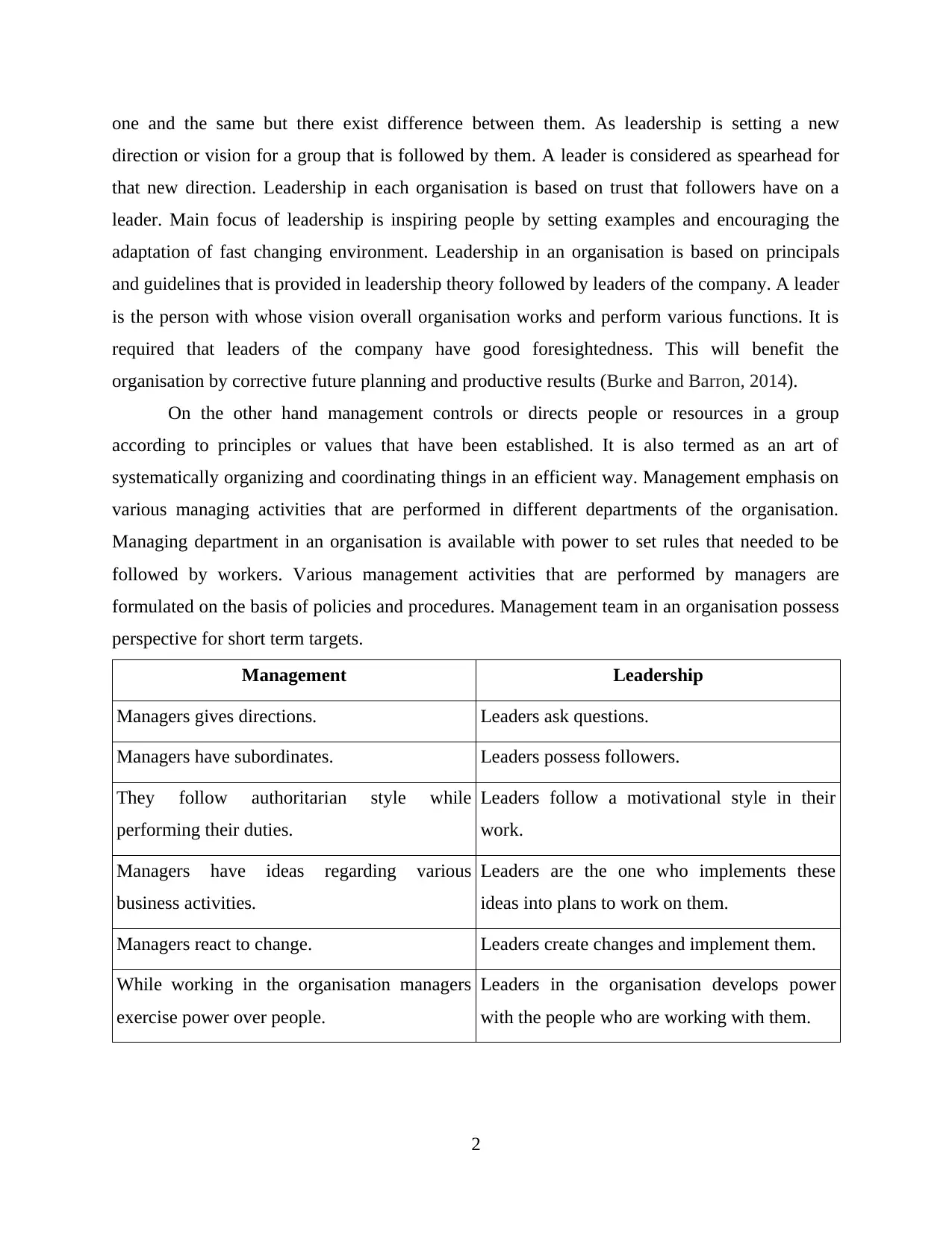
one and the same but there exist difference between them. As leadership is setting a new
direction or vision for a group that is followed by them. A leader is considered as spearhead for
that new direction. Leadership in each organisation is based on trust that followers have on a
leader. Main focus of leadership is inspiring people by setting examples and encouraging the
adaptation of fast changing environment. Leadership in an organisation is based on principals
and guidelines that is provided in leadership theory followed by leaders of the company. A leader
is the person with whose vision overall organisation works and perform various functions. It is
required that leaders of the company have good foresightedness. This will benefit the
organisation by corrective future planning and productive results (Burke and Barron, 2014).
On the other hand management controls or directs people or resources in a group
according to principles or values that have been established. It is also termed as an art of
systematically organizing and coordinating things in an efficient way. Management emphasis on
various managing activities that are performed in different departments of the organisation.
Managing department in an organisation is available with power to set rules that needed to be
followed by workers. Various management activities that are performed by managers are
formulated on the basis of policies and procedures. Management team in an organisation possess
perspective for short term targets.
Management Leadership
Managers gives directions. Leaders ask questions.
Managers have subordinates. Leaders possess followers.
They follow authoritarian style while
performing their duties.
Leaders follow a motivational style in their
work.
Managers have ideas regarding various
business activities.
Leaders are the one who implements these
ideas into plans to work on them.
Managers react to change. Leaders create changes and implement them.
While working in the organisation managers
exercise power over people.
Leaders in the organisation develops power
with the people who are working with them.
2
direction or vision for a group that is followed by them. A leader is considered as spearhead for
that new direction. Leadership in each organisation is based on trust that followers have on a
leader. Main focus of leadership is inspiring people by setting examples and encouraging the
adaptation of fast changing environment. Leadership in an organisation is based on principals
and guidelines that is provided in leadership theory followed by leaders of the company. A leader
is the person with whose vision overall organisation works and perform various functions. It is
required that leaders of the company have good foresightedness. This will benefit the
organisation by corrective future planning and productive results (Burke and Barron, 2014).
On the other hand management controls or directs people or resources in a group
according to principles or values that have been established. It is also termed as an art of
systematically organizing and coordinating things in an efficient way. Management emphasis on
various managing activities that are performed in different departments of the organisation.
Managing department in an organisation is available with power to set rules that needed to be
followed by workers. Various management activities that are performed by managers are
formulated on the basis of policies and procedures. Management team in an organisation possess
perspective for short term targets.
Management Leadership
Managers gives directions. Leaders ask questions.
Managers have subordinates. Leaders possess followers.
They follow authoritarian style while
performing their duties.
Leaders follow a motivational style in their
work.
Managers have ideas regarding various
business activities.
Leaders are the one who implements these
ideas into plans to work on them.
Managers react to change. Leaders create changes and implement them.
While working in the organisation managers
exercise power over people.
Leaders in the organisation develops power
with the people who are working with them.
2
⊘ This is a preview!⊘
Do you want full access?
Subscribe today to unlock all pages.

Trusted by 1+ million students worldwide
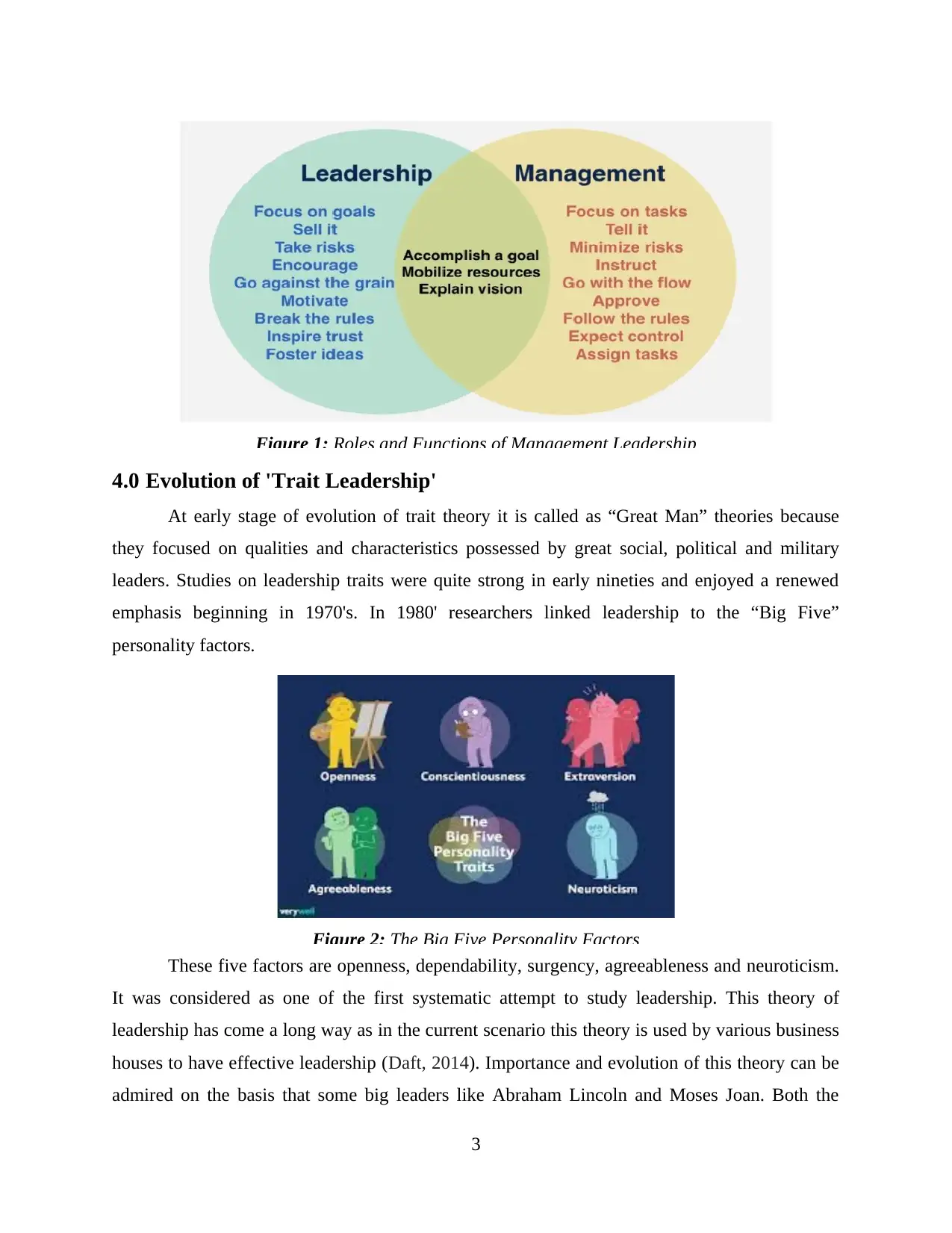
Figure 1: Roles and Functions of Management Leadership
4.0 Evolution of 'Trait Leadership'
At early stage of evolution of trait theory it is called as “Great Man” theories because
they focused on qualities and characteristics possessed by great social, political and military
leaders. Studies on leadership traits were quite strong in early nineties and enjoyed a renewed
emphasis beginning in 1970's. In 1980' researchers linked leadership to the “Big Five”
personality factors.
Figure 2: The Big Five Personality Factors
These five factors are openness, dependability, surgency, agreeableness and neuroticism.
It was considered as one of the first systematic attempt to study leadership. This theory of
leadership has come a long way as in the current scenario this theory is used by various business
houses to have effective leadership (Daft, 2014). Importance and evolution of this theory can be
admired on the basis that some big leaders like Abraham Lincoln and Moses Joan. Both the
3
4.0 Evolution of 'Trait Leadership'
At early stage of evolution of trait theory it is called as “Great Man” theories because
they focused on qualities and characteristics possessed by great social, political and military
leaders. Studies on leadership traits were quite strong in early nineties and enjoyed a renewed
emphasis beginning in 1970's. In 1980' researchers linked leadership to the “Big Five”
personality factors.
Figure 2: The Big Five Personality Factors
These five factors are openness, dependability, surgency, agreeableness and neuroticism.
It was considered as one of the first systematic attempt to study leadership. This theory of
leadership has come a long way as in the current scenario this theory is used by various business
houses to have effective leadership (Daft, 2014). Importance and evolution of this theory can be
admired on the basis that some big leaders like Abraham Lincoln and Moses Joan. Both the
3
Paraphrase This Document
Need a fresh take? Get an instant paraphrase of this document with our AI Paraphraser

leaders were great influencer on large group of individuals. Qualities that they possess was not
learned by then but it was in born to them. Trait theory has evolved a lot and used in current
business entities to have effective leadership.
5.0 Major Constituents of 'Traits Leadership' theory
As this theory of leadership says that leaders are born they can not be made. This
statement indicates that individuals possess variety of skills that are available with them since the
beginning. Some skills can be developed over a period of time but skills that a good leader needs
to have must be present in then since they born as it can be taught. There are some major traits
that a leader possess while using this form of leadership which is intelligence, determination,
self-confidence, integrity and sociability. These must be present in each leader while following
trait leadership theory.
Intelligence: In general sense it is the capacity of an individual to put logic,
understanding, self-awareness, learning, knowledge, planning, reasoning, creativity and solving
various issues. A leader must be intelligent and smart enough to lead all the employees and
subordinates in the organisation. Intelligence got evolved and enhanced with experience and
passage of time (Ghasabeh Soosay and Reaiche, 2015). This is a essential requirement to be
intelligent as leader is the person who deals with various difficult situations and motivate others
to work hard. Intelligence will also help leaders to take decision by understanding complete
scenario that may influence decision making. Together with this emotional intelligence plays a
great role in maintaining positive relationships with peoples around and being successful leaders.
Leaders of the organisation needs to be emotionally strong and intelligent to take effective and
productive results. A emotionally intelligent leader knows how to react to various circumstances
and motivate followers instead of the difficult circumstances.
Determination: It is a positive emotional feeling that involves preserving towards a goal.
Leaders of every organisation should be determined towards achieving organisational objective
and encouraging subordinates to work in the same direction (Huber, 2017). It is one of the
important trait in leadership that generates desire to get job done and includes characteristics
such as initiative, persistence, dominance and drive. Leaders are the role-model of workers that
are associated with the organisation and determination is required to maintain momentum
towards goals and to inspire others. A determined leader towards work have a clear vision of the
preferred future and encourage and inspire others even things seems to be heading the wrong
4
learned by then but it was in born to them. Trait theory has evolved a lot and used in current
business entities to have effective leadership.
5.0 Major Constituents of 'Traits Leadership' theory
As this theory of leadership says that leaders are born they can not be made. This
statement indicates that individuals possess variety of skills that are available with them since the
beginning. Some skills can be developed over a period of time but skills that a good leader needs
to have must be present in then since they born as it can be taught. There are some major traits
that a leader possess while using this form of leadership which is intelligence, determination,
self-confidence, integrity and sociability. These must be present in each leader while following
trait leadership theory.
Intelligence: In general sense it is the capacity of an individual to put logic,
understanding, self-awareness, learning, knowledge, planning, reasoning, creativity and solving
various issues. A leader must be intelligent and smart enough to lead all the employees and
subordinates in the organisation. Intelligence got evolved and enhanced with experience and
passage of time (Ghasabeh Soosay and Reaiche, 2015). This is a essential requirement to be
intelligent as leader is the person who deals with various difficult situations and motivate others
to work hard. Intelligence will also help leaders to take decision by understanding complete
scenario that may influence decision making. Together with this emotional intelligence plays a
great role in maintaining positive relationships with peoples around and being successful leaders.
Leaders of the organisation needs to be emotionally strong and intelligent to take effective and
productive results. A emotionally intelligent leader knows how to react to various circumstances
and motivate followers instead of the difficult circumstances.
Determination: It is a positive emotional feeling that involves preserving towards a goal.
Leaders of every organisation should be determined towards achieving organisational objective
and encouraging subordinates to work in the same direction (Huber, 2017). It is one of the
important trait in leadership that generates desire to get job done and includes characteristics
such as initiative, persistence, dominance and drive. Leaders are the role-model of workers that
are associated with the organisation and determination is required to maintain momentum
towards goals and to inspire others. A determined leader towards work have a clear vision of the
preferred future and encourage and inspire others even things seems to be heading the wrong
4
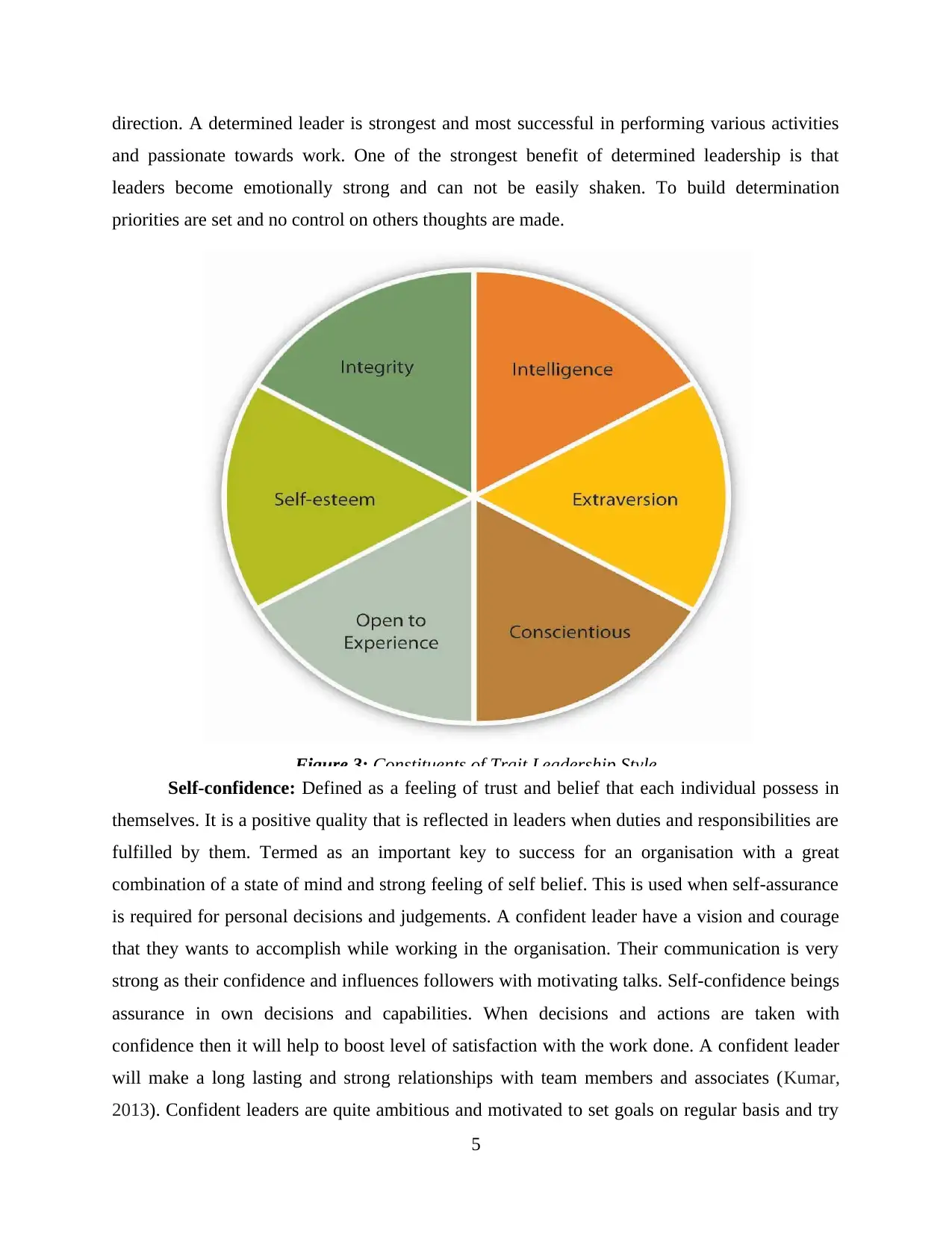
direction. A determined leader is strongest and most successful in performing various activities
and passionate towards work. One of the strongest benefit of determined leadership is that
leaders become emotionally strong and can not be easily shaken. To build determination
priorities are set and no control on others thoughts are made.
Figure 3: Constituents of Trait Leadership Style
Self-confidence: Defined as a feeling of trust and belief that each individual possess in
themselves. It is a positive quality that is reflected in leaders when duties and responsibilities are
fulfilled by them. Termed as an important key to success for an organisation with a great
combination of a state of mind and strong feeling of self belief. This is used when self-assurance
is required for personal decisions and judgements. A confident leader have a vision and courage
that they wants to accomplish while working in the organisation. Their communication is very
strong as their confidence and influences followers with motivating talks. Self-confidence beings
assurance in own decisions and capabilities. When decisions and actions are taken with
confidence then it will help to boost level of satisfaction with the work done. A confident leader
will make a long lasting and strong relationships with team members and associates (Kumar,
2013). Confident leaders are quite ambitious and motivated to set goals on regular basis and try
5
and passionate towards work. One of the strongest benefit of determined leadership is that
leaders become emotionally strong and can not be easily shaken. To build determination
priorities are set and no control on others thoughts are made.
Figure 3: Constituents of Trait Leadership Style
Self-confidence: Defined as a feeling of trust and belief that each individual possess in
themselves. It is a positive quality that is reflected in leaders when duties and responsibilities are
fulfilled by them. Termed as an important key to success for an organisation with a great
combination of a state of mind and strong feeling of self belief. This is used when self-assurance
is required for personal decisions and judgements. A confident leader have a vision and courage
that they wants to accomplish while working in the organisation. Their communication is very
strong as their confidence and influences followers with motivating talks. Self-confidence beings
assurance in own decisions and capabilities. When decisions and actions are taken with
confidence then it will help to boost level of satisfaction with the work done. A confident leader
will make a long lasting and strong relationships with team members and associates (Kumar,
2013). Confident leaders are quite ambitious and motivated to set goals on regular basis and try
5
⊘ This is a preview!⊘
Do you want full access?
Subscribe today to unlock all pages.

Trusted by 1+ million students worldwide
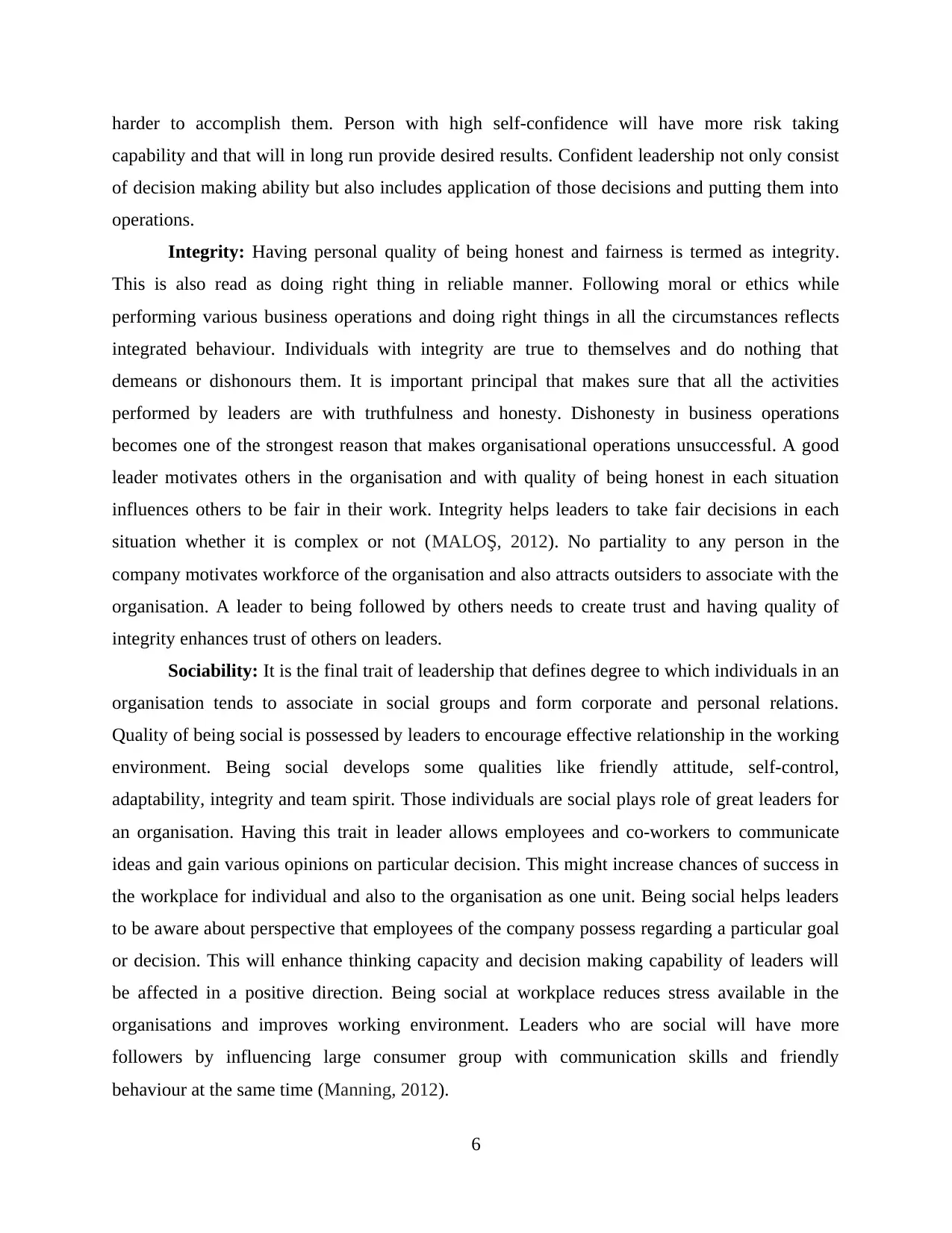
harder to accomplish them. Person with high self-confidence will have more risk taking
capability and that will in long run provide desired results. Confident leadership not only consist
of decision making ability but also includes application of those decisions and putting them into
operations.
Integrity: Having personal quality of being honest and fairness is termed as integrity.
This is also read as doing right thing in reliable manner. Following moral or ethics while
performing various business operations and doing right things in all the circumstances reflects
integrated behaviour. Individuals with integrity are true to themselves and do nothing that
demeans or dishonours them. It is important principal that makes sure that all the activities
performed by leaders are with truthfulness and honesty. Dishonesty in business operations
becomes one of the strongest reason that makes organisational operations unsuccessful. A good
leader motivates others in the organisation and with quality of being honest in each situation
influences others to be fair in their work. Integrity helps leaders to take fair decisions in each
situation whether it is complex or not (MALOŞ, 2012). No partiality to any person in the
company motivates workforce of the organisation and also attracts outsiders to associate with the
organisation. A leader to being followed by others needs to create trust and having quality of
integrity enhances trust of others on leaders.
Sociability: It is the final trait of leadership that defines degree to which individuals in an
organisation tends to associate in social groups and form corporate and personal relations.
Quality of being social is possessed by leaders to encourage effective relationship in the working
environment. Being social develops some qualities like friendly attitude, self-control,
adaptability, integrity and team spirit. Those individuals are social plays role of great leaders for
an organisation. Having this trait in leader allows employees and co-workers to communicate
ideas and gain various opinions on particular decision. This might increase chances of success in
the workplace for individual and also to the organisation as one unit. Being social helps leaders
to be aware about perspective that employees of the company possess regarding a particular goal
or decision. This will enhance thinking capacity and decision making capability of leaders will
be affected in a positive direction. Being social at workplace reduces stress available in the
organisations and improves working environment. Leaders who are social will have more
followers by influencing large consumer group with communication skills and friendly
behaviour at the same time (Manning, 2012).
6
capability and that will in long run provide desired results. Confident leadership not only consist
of decision making ability but also includes application of those decisions and putting them into
operations.
Integrity: Having personal quality of being honest and fairness is termed as integrity.
This is also read as doing right thing in reliable manner. Following moral or ethics while
performing various business operations and doing right things in all the circumstances reflects
integrated behaviour. Individuals with integrity are true to themselves and do nothing that
demeans or dishonours them. It is important principal that makes sure that all the activities
performed by leaders are with truthfulness and honesty. Dishonesty in business operations
becomes one of the strongest reason that makes organisational operations unsuccessful. A good
leader motivates others in the organisation and with quality of being honest in each situation
influences others to be fair in their work. Integrity helps leaders to take fair decisions in each
situation whether it is complex or not (MALOŞ, 2012). No partiality to any person in the
company motivates workforce of the organisation and also attracts outsiders to associate with the
organisation. A leader to being followed by others needs to create trust and having quality of
integrity enhances trust of others on leaders.
Sociability: It is the final trait of leadership that defines degree to which individuals in an
organisation tends to associate in social groups and form corporate and personal relations.
Quality of being social is possessed by leaders to encourage effective relationship in the working
environment. Being social develops some qualities like friendly attitude, self-control,
adaptability, integrity and team spirit. Those individuals are social plays role of great leaders for
an organisation. Having this trait in leader allows employees and co-workers to communicate
ideas and gain various opinions on particular decision. This might increase chances of success in
the workplace for individual and also to the organisation as one unit. Being social helps leaders
to be aware about perspective that employees of the company possess regarding a particular goal
or decision. This will enhance thinking capacity and decision making capability of leaders will
be affected in a positive direction. Being social at workplace reduces stress available in the
organisations and improves working environment. Leaders who are social will have more
followers by influencing large consumer group with communication skills and friendly
behaviour at the same time (Manning, 2012).
6
Paraphrase This Document
Need a fresh take? Get an instant paraphrase of this document with our AI Paraphraser
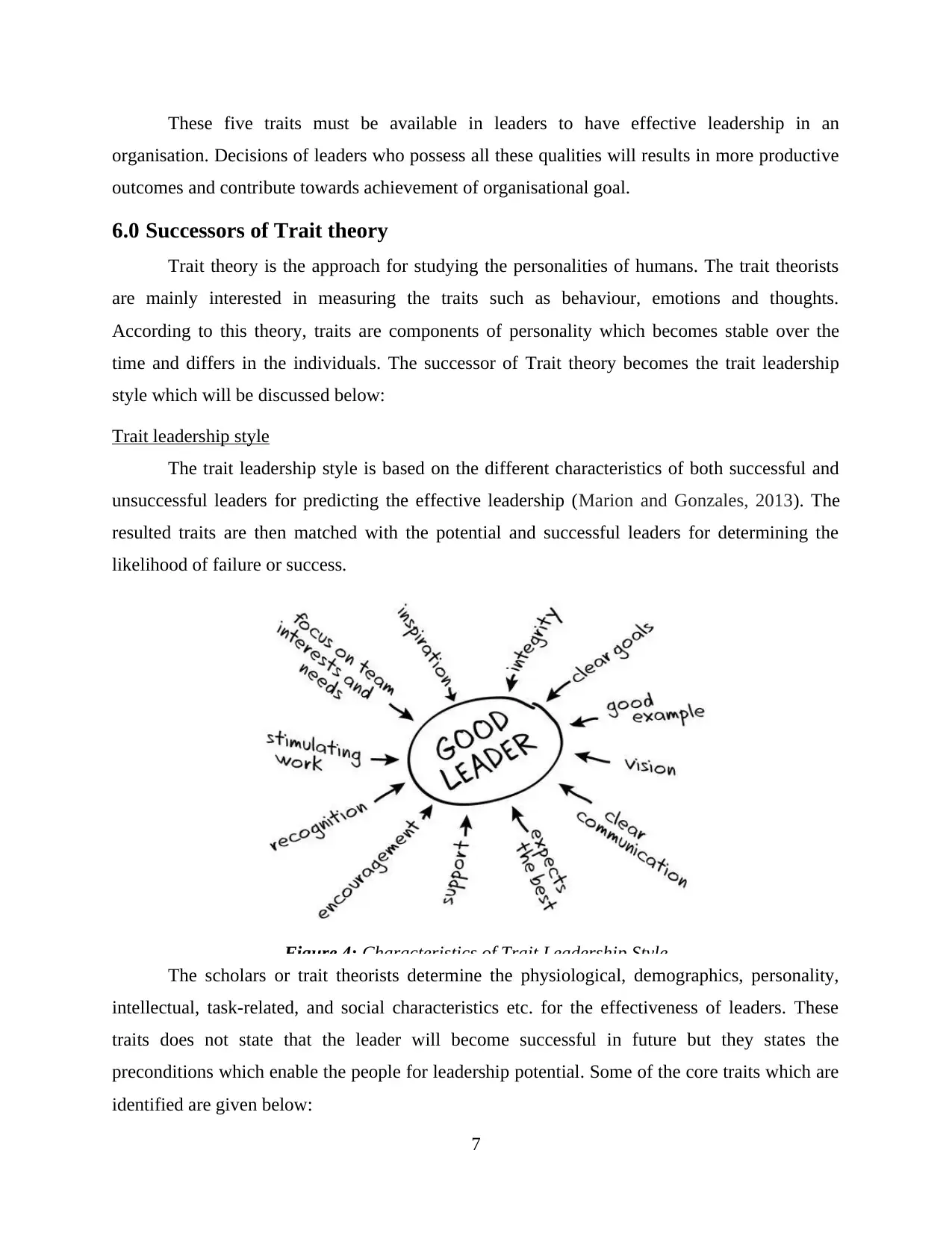
These five traits must be available in leaders to have effective leadership in an
organisation. Decisions of leaders who possess all these qualities will results in more productive
outcomes and contribute towards achievement of organisational goal.
6.0 Successors of Trait theory
Trait theory is the approach for studying the personalities of humans. The trait theorists
are mainly interested in measuring the traits such as behaviour, emotions and thoughts.
According to this theory, traits are components of personality which becomes stable over the
time and differs in the individuals. The successor of Trait theory becomes the trait leadership
style which will be discussed below:
Trait leadership style
The trait leadership style is based on the different characteristics of both successful and
unsuccessful leaders for predicting the effective leadership (Marion and Gonzales, 2013). The
resulted traits are then matched with the potential and successful leaders for determining the
likelihood of failure or success.
Figure 4: Characteristics of Trait Leadership Style
The scholars or trait theorists determine the physiological, demographics, personality,
intellectual, task-related, and social characteristics etc. for the effectiveness of leaders. These
traits does not state that the leader will become successful in future but they states the
preconditions which enable the people for leadership potential. Some of the core traits which are
identified are given below:
7
organisation. Decisions of leaders who possess all these qualities will results in more productive
outcomes and contribute towards achievement of organisational goal.
6.0 Successors of Trait theory
Trait theory is the approach for studying the personalities of humans. The trait theorists
are mainly interested in measuring the traits such as behaviour, emotions and thoughts.
According to this theory, traits are components of personality which becomes stable over the
time and differs in the individuals. The successor of Trait theory becomes the trait leadership
style which will be discussed below:
Trait leadership style
The trait leadership style is based on the different characteristics of both successful and
unsuccessful leaders for predicting the effective leadership (Marion and Gonzales, 2013). The
resulted traits are then matched with the potential and successful leaders for determining the
likelihood of failure or success.
Figure 4: Characteristics of Trait Leadership Style
The scholars or trait theorists determine the physiological, demographics, personality,
intellectual, task-related, and social characteristics etc. for the effectiveness of leaders. These
traits does not state that the leader will become successful in future but they states the
preconditions which enable the people for leadership potential. Some of the core traits which are
identified are given below:
7
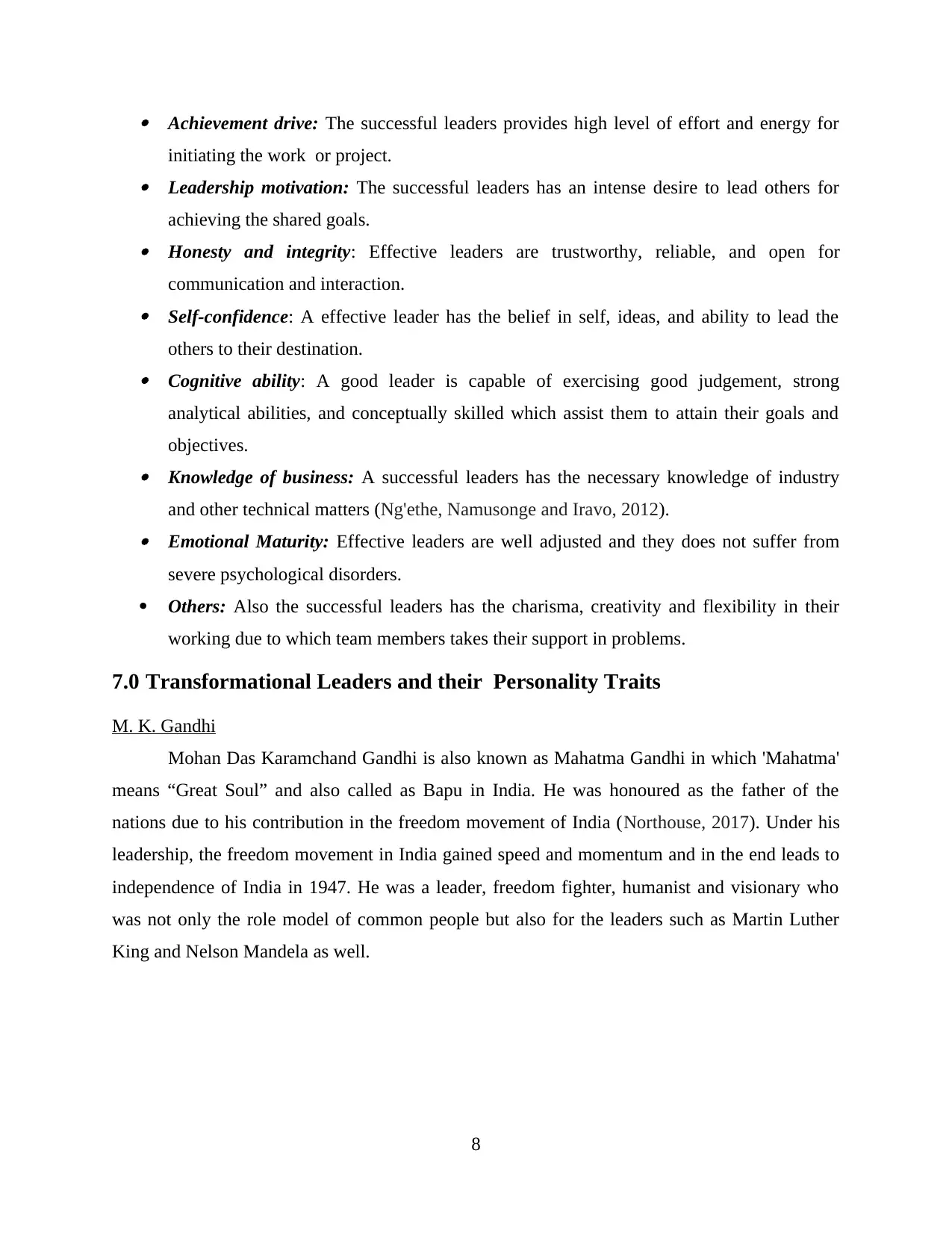
Achievement drive: The successful leaders provides high level of effort and energy for
initiating the work or project. Leadership motivation: The successful leaders has an intense desire to lead others for
achieving the shared goals. Honesty and integrity: Effective leaders are trustworthy, reliable, and open for
communication and interaction. Self-confidence: A effective leader has the belief in self, ideas, and ability to lead the
others to their destination. Cognitive ability: A good leader is capable of exercising good judgement, strong
analytical abilities, and conceptually skilled which assist them to attain their goals and
objectives. Knowledge of business: A successful leaders has the necessary knowledge of industry
and other technical matters (Ng'ethe, Namusonge and Iravo, 2012). Emotional Maturity: Effective leaders are well adjusted and they does not suffer from
severe psychological disorders.
Others: Also the successful leaders has the charisma, creativity and flexibility in their
working due to which team members takes their support in problems.
7.0 Transformational Leaders and their Personality Traits
M. K. Gandhi
Mohan Das Karamchand Gandhi is also known as Mahatma Gandhi in which 'Mahatma'
means “Great Soul” and also called as Bapu in India. He was honoured as the father of the
nations due to his contribution in the freedom movement of India (Northouse, 2017). Under his
leadership, the freedom movement in India gained speed and momentum and in the end leads to
independence of India in 1947. He was a leader, freedom fighter, humanist and visionary who
was not only the role model of common people but also for the leaders such as Martin Luther
King and Nelson Mandela as well.
8
initiating the work or project. Leadership motivation: The successful leaders has an intense desire to lead others for
achieving the shared goals. Honesty and integrity: Effective leaders are trustworthy, reliable, and open for
communication and interaction. Self-confidence: A effective leader has the belief in self, ideas, and ability to lead the
others to their destination. Cognitive ability: A good leader is capable of exercising good judgement, strong
analytical abilities, and conceptually skilled which assist them to attain their goals and
objectives. Knowledge of business: A successful leaders has the necessary knowledge of industry
and other technical matters (Ng'ethe, Namusonge and Iravo, 2012). Emotional Maturity: Effective leaders are well adjusted and they does not suffer from
severe psychological disorders.
Others: Also the successful leaders has the charisma, creativity and flexibility in their
working due to which team members takes their support in problems.
7.0 Transformational Leaders and their Personality Traits
M. K. Gandhi
Mohan Das Karamchand Gandhi is also known as Mahatma Gandhi in which 'Mahatma'
means “Great Soul” and also called as Bapu in India. He was honoured as the father of the
nations due to his contribution in the freedom movement of India (Northouse, 2017). Under his
leadership, the freedom movement in India gained speed and momentum and in the end leads to
independence of India in 1947. He was a leader, freedom fighter, humanist and visionary who
was not only the role model of common people but also for the leaders such as Martin Luther
King and Nelson Mandela as well.
8
⊘ This is a preview!⊘
Do you want full access?
Subscribe today to unlock all pages.

Trusted by 1+ million students worldwide
1 out of 19
Related Documents
Your All-in-One AI-Powered Toolkit for Academic Success.
+13062052269
info@desklib.com
Available 24*7 on WhatsApp / Email
![[object Object]](/_next/static/media/star-bottom.7253800d.svg)
Unlock your academic potential
Copyright © 2020–2025 A2Z Services. All Rights Reserved. Developed and managed by ZUCOL.




